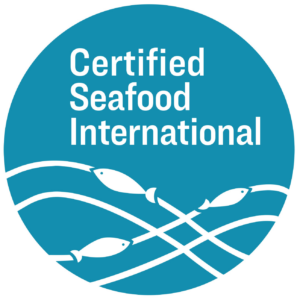Pacific Whiting (Hake)
The Pacific whiting fishery (Merluccius productus) was awarded certification in July 2022. Vessels operating in the certified Pacific whiting fishery primarily employ pelagic trawl gear. Fishing occurs in federal waters of the United States Exclusive Economic Zone off the U.S. West Coast and is jointly managed by the Pacific Fishery Management Council (PFMC) and the National Marine Fisheries Service (NMFS). Pacific whiting is also often referred to as Pacific hake.
Certification Reports
- Pacific Whiting Conservation Cooperative, in collaboration with all sectors of the U.S. whiting fishery
- Pacific Whiting Certificate
- Pacific Whiting Annual Surveillance and Team Announcement – Sept 2025
- Pacific Whiting Surveillance Final Report – Jan 2025
- Pacific Whiting Annual Surveillance and Team Announcement – Sept 2024
- Pacific Whiting Surveillance Final Report – Oct 2023
- Pacific Whiting Annual Surveillance and Team Announcement – June 2023
- Final Assessment Report for Pacific Whiting Fishery July 2022
- PUBLIC COMMENT REQUESTED: For Full Assessment Report of Pacific Whiting Fishery
- Public Comment Announcement from CB – comments due by 1700 UTC July 22, 2022
- To register to comment or to submit a comment, contact: Amanda Stern-Pirlot, MRAG Americas, Inc. | +1 206-669-0439 | certification@mragamericas.com
- Public Comment Announcement from CB – comments due by 1700 UTC July 22, 2022
- Announcement of Assessment, Team and Site Visits – December 2021
Fishery Info
Fishing for U.S. Pacific whiting occurs in federal waters of the United States Exclusive Economic Zone (EEZ) off the coasts of Washington, Oregon and California. Fishing is generally permitted between May and December each year.

U.S. Pacific whiting are harvested primarily by using pelagic trawl gear, which is characterized by a cone-shaped net and trawl doors that are suspended in the mid-water zone. Pelagic trawls achieve a vertical net opening by attaching clump weights to the lower wingtips of the net, which spread the net downwards and allow it to achieve neutral buoyancy. The bare chain footrope and clump weights may contact the seafloor. Pelagic trawl design is also characterized by large forward meshes that herd fish. This simultaneously allows for more efficient drag and excludes non-target demersal species.
Management of the U.S. Pacific whiting fishery is conducted jointly by the Pacific Fishery Management Council (PFMC) and the National Marine Fisheries Service (NMFS). In accordance with the requirements of the U.S. Magnuson-Stevens Fishery Conservation and Management Act (MSA), the PFMC establishes science-based annual catch limits for the federal Pacific whiting fishery, and NMFS develops and enforces federal regulations.
Vessels harvesting whiting that is certified by CSI under the U.S. Pacific whiting certificate operate exclusively within federal waters of the United States Exclusive Economic Zone (EEZ) and the state waters of Washington, Oregon, and California. U.S. federal and state laws regulate the treatment of workers on vessels that harvest certified Pacific whiting.
Additionally, the catcher-processor and processing fleets that participate in the U.S. Pacific whiting fishery have voluntarily certified to the FISH Standard for Crew. FISH is an independent third-party certification program for labour practices on vessels in wild-capture fisheries around the globe. Learn more here.
Pacific whiting (also called Pacific hake) is a favorite for its subtle, sweet flavor and soft, flaky texture. It’s ideal for both seasoned seafood lovers and those new to fish because it absorbs marinades and seasonings well without overwhelming the dish.
Pacific whiting has a mild, slightly sweet flavor that’s less “fishy” than many other seafood options, making it versatile and ideal for various recipes.
Whiting is a good source of selenium, vitamin B, magnesium, and protein.
Pacific Whiting (Hake)
Serving Size: 100g raw
Source: https://www.fisheries.noaa.gov/species/pacific-whiting/seafood

